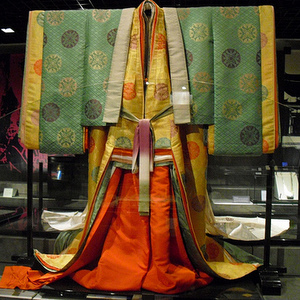Junihitoe
- Japanese: 十二単 (juunihitoe)
Jûnihitoe (lit. "twelve layers") is a style of arrangement of multiple layers of garments, strongly associated with court ladies of the Heian period. Despite the name, the number of layers was not necessarily always, or even typically, twelve.[1] The style became dominant in the late Heian period, replacing styles of garments more closely derived from Chinese court costume, and remained the standard form of dress for court ladies for centuries afterward; the term jûnihitoe was prominently used to refer to this form of dress up until the 14th century.
The choice of colors for each layer had great significance, and were carefully chosen for each woman, or for each occasion. The robes were quite heavy, weighing roughly 12 kg, or more than 26 lbs, and were quite long, dragging behind their wearer like the train on a gown. Paintings of Heian period court ladies, such as the Genji monogatari emaki, often depict them as merely faces with long black hair, amid a sea of colored cloth - the form of their bodies is completely obscured, as are their legs and feet.
References
- Gallery labels at Museum of Kyoto.
